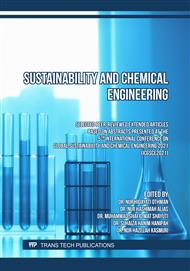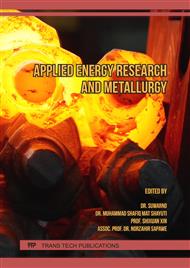[1]
A.A. Olajire, Review of ASP EOR (alkaline surfactant polymer enhanced oil recovery) technology in the petroleum industry: Prospects and challenges, Energy. 77 (2014) 963–982.
DOI: 10.1016/j.energy.2014.09.005
Google Scholar
[2]
T.A.T. Mohd, M.Z. Jaafar, A.A.A. Rasol, M.F. Hamid, Measurement of streaming potential in downhole application: An insight for enhanced oil recovery monitoring, MATEC Web Conf. 87 (2017) 03002.
DOI: 10.1051/matecconf/20178703002
Google Scholar
[3]
T.A.T. Mohd, M.Z. Jaafar, A.A.A. Rasol, J. Ali, A new prospect of streaming potential measurement in alkaline-surfactant polymer flooding, Chem. Eng. Trans. 56 (2017) 1183–1188.
Google Scholar
[4]
P.A. Owusu, S. Asumadu-sarkodie, A review of renewable energy sources, sustainability issues and climate change mitigation, Civil & Environmental Engineering Review Article (2016) 1–14.
DOI: 10.1080/23311916.2016.1167990
Google Scholar
[5]
G.J. Hirasaki, C.A. Miller, M. Puerto, Recent advances in surfactant EOR, SPE Journal. (2011) 889-907.
DOI: 10.2118/115386-pa
Google Scholar
[6]
H. ShamsiJazeyi, R. Verduzco, G.J. Hirasaki, Reducing adsorption of anionic surfactant for enhanced oil recovery: Part II. Applied aspects, Colloids Surf. A: Physicochem. Eng. Asp. 453 (2014) 168–175.
DOI: 10.1016/j.colsurfa.2014.02.021
Google Scholar
[7]
A.F. Belhaj, K.A. Elraies, S.M. Mahmood, N.N. Zulkifli, S. Akbari, O.S.E. Hussien, The effect of surfactant concentration, salinity, temperature, and pH on surfactant adsorption for chemical enhanced oil recovery: a review, J. Pet. Explor. Prod. Technol. 10 (2020) 125–137.
DOI: 10.1007/s13202-019-0685-y
Google Scholar
[8]
K. Ma, L. Cui, Y. Dong, T. Wang, C. Da, G.J. Hirasaki, S.L. Biswal, Adsorption of cationic and anionic surfactants on natural and synthetic, J. Colloid Interface Sci. 408 (2013) 164–172.
DOI: 10.1016/j.jcis.2013.07.006
Google Scholar
[9]
M.R. Azam, I.M. Tan, L. Ismail, M. Mushtaq, M. Nadeem, M. Sagir, Kinetics and Equilibria of Synthesized Anionic Surfactant onto Berea Sandstone, J. Dispers. Sci. Technol. 35 (2014) 223–230.
DOI: 10.1080/01932691.2013.783491
Google Scholar
[10]
M.R. Azam, I.M. Tan, L. Ismail, M. Mushtaq, M. Nadeem, M. Sagir, Static adsorption of anionic surfactant onto crushed Berea sandstone, J. Pet. Explor. Prod. Technol. 3 (2013) 195–201.
DOI: 10.1007/s13202-013-0057-y
Google Scholar
[11]
J. Van Erum, D. Van Dam, P.P. De Deyn, Alzheimer's disease: Neurotransmitters of the sleep-wake cycle, Neurosci. Biobehav. Rev. 105 (2019) 72–80.
DOI: 10.1016/j.neubiorev.2019.07.019
Google Scholar
[12]
T.A.T. Mohd, M.Z. Jaafar, Adsorption of anionic sodium dodecyl sulfate surfactant on local sand and kaolinite surfaces: the prospect of alkaline and salinity, Recent Technol. Eng. 7 (2019) 2277-3878.
Google Scholar
[13]
H. Zhang, M. Dong, S. Zhao, Experimental study of the interaction between NaOH, surfactant, and polymer in reducing court heavy oil/brine interfacial tension. Energy Fuels. 26 (2012) 3644–3650.
DOI: 10.1021/ef300498r
Google Scholar
[14]
J.J. Sheng, Critical review of alkaline-polymer flooding, J. Petrol. Explor. Prod. Technol. 7 (2017) 147–153.
DOI: 10.1007/s13202-016-0239-5
Google Scholar
[15]
A. Azdarpour, R. Junin, M. Manan, H. Hamidi, R. Rafati, The effects of controlling parameters on polymer enhanced foam (PEF) stability, J. Teknol. 73 (2015) 53–59.
DOI: 10.11113/jt.v73.1701
Google Scholar
[16]
T.A.T. Mohd, N. Alias, N.A. Ghazali, E. Yahya, A. Sauki, A. Azizi, N.M. Yusof, Mobility investigation of nanoparticle-stabilized carbon dioxide foam for enhanced oil recovery (EOR), Adv. Mat. Res. 1119 (2015) 90–95.
DOI: 10.4028/www.scientific.net/amr.1119.90
Google Scholar
[17]
T.A.T. Mohd, N.F. Abu Bakar, N. Awang, A.A. Talib, Aqueous foams stabilized with silica nanoparticle and alpha olefin sulfonates surfactant, J. Mech. Eng. Sci. 12 (2018) 3759–3770.
Google Scholar
[18]
A. Azizi, H. Husin, N.A. Ghazali, M.K. Khairudin, A. Sauki, N.H. Alias, T.A.T. Mohd, Nanoparticles stabilized carbon dioxide foams in sandstone and limestone reservoir, Adv. Mat. Res. 1119 (2015) 170–174.
DOI: 10.4028/www.scientific.net/amr.1119.170
Google Scholar
[19]
N.S.M. Azmi, N.F.A. Bakar, T.A.T. Mohd, A. Azizi, Molecular dynamics simulation on CO2 foam system with addition of SiO2 nanoparticles at various sodium dodecyl sulfate (SDS) concentrations and elevated temperatures for enhanced oil recovery (EOR) application, Comput. Mater. Sci. 184 (2020) 109937.
DOI: 10.1016/j.commatsci.2020.109937
Google Scholar
[20]
B. Tanhaei, N. Saghatoleslami, M.P. Chenar, A. Ayati, M. Hesampour, M. Mänttäri, Experimental study of CMC evaluation in single and mixed surfactant systems, using the UV-Vis spectroscopic method, J. Surfactants Deterg. 16 (2013) 357–362.
DOI: 10.1007/s11743-012-1403-7
Google Scholar
[21]
S. Najimi, I. Nowrouzi, A. Khaksar Manshad, A.H. Mohammadi, Experimental study of the performances of commercial surfactants in reducing interfacial tension and wettability alteration in the process of chemical water injection into carbonate reservoirs, J. Pet. Explor. Prod. Technol. 10 (2019) 1551–1563.
DOI: 10.1007/s13202-019-00789-0
Google Scholar
[22]
N. Saxena, A. Kumar, A. Mandal, Adsorption analysis of natural anionic surfactant for enhanced oil recovery: The role of mineralogy, salinity, alkalinity and nanoparticles, J. Pet. Sci. Eng. 173 (2019) 1264-1283.
DOI: 10.1016/j.petrol.2018.11.002
Google Scholar
[23]
C.T.Q. Dang, Z. Chen, N.T.B. Nguyen, W. Bae, T.H. Phung, Development of isotherm polymer/surfactant adsorption models in chemical flooding, SPE Asia Pacific Oil & Gas Conference and Exhibition, Jakarta, Indonesia, (2011).
DOI: 10.2118/147872-ms
Google Scholar
[24]
L. Saunders, Surface and Colloid Chemistry, J. Pharm. Pharmacol. 3 (1951) 865–882.
Google Scholar
[25]
W. Kwok, R.E. Hayes, H.A. Nasr-El-Din, Modelling dynamic adsorption of an anionic surfactant on Berea sandstone with radial flow, Chem. Eng. Sci. 50 (1995) 769–783.
DOI: 10.1016/0009-2509(94)00450-6
Google Scholar
[26]
A. Tabatabal, M.V. Gonzalez, J.H. Harwell, J.F. Scamehorn, Reducing surfactant adsorption in carbonate reservoirs, SPE Reserv. Eng. 8 (1993) 117–122.
DOI: 10.2118/24105-pa
Google Scholar
[27]
E.J. Wanless, W.A. Ducker, Weak influence of divalent ions on anionic surfactant surface-aggregation, Langmuir. 13 (1997) 1463–1474.
DOI: 10.1021/la960861e
Google Scholar
[28]
S. Elias, A. Rabiu, O. Oyekola, B. Seima, Adsorption characteristics of surfactants on different petroleum reservoir materials, The Online J. Sci. Technol. 6 (2016) 6–16.
Google Scholar
[29]
J.J. Sheng, Surfactant Flooding, Modern Chemical Enhanced Oil Recovery: Theory and Practice, (2011).
Google Scholar
[30]
S. Thomas and S.M. Farouq Ali, Micellar flooding and ASP - chemical methods for enhanced oil recovery, J. Can. Pet. Technol. 40 (2001) 46–52.
DOI: 10.2118/01-02-04
Google Scholar



